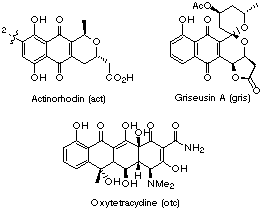
Biosynthesis of Type II Bacterial Polyketides
Dr R. J. Cox, Dr J. Crosby, Prof. T. J. Simpson

Dr Anne-Lise Matharu
Polyketides produced by bacteria and fungi posess a very wide range of pharmaceutical properties, including antibiotic, antifungal, antitumor and antiparasitc activities. Extensive strain screening has identified many useful polyketide derived compounds of both 'macrolide' and 'polyaromatic' type produced by bacteria. In order to understand the biosynthetic processes involved in polyketide production classical studies have focussed on feeding experiments. Newer strategies are concentrating on the study of the enzyme complexes (polyketide synthases, PKS) themselves. In particular multidisciplinary groups in Cambridge, supported by Pfizer, Glaxo and others are studying the biosynthesis of macrolides such as rapamycin and erythromycin. In the USA, Lilly, Abbott and others are following similar paths in the hope of directing biosynthesis towards novel compounds with potential applications in the pharmaceutical area. Our approach is to examine the 'polyaromatic' class of bacterial polyketides produced by so-called Type II PKS enzyme complexes. These compounds include antibiotics such as oxytetracycline and actinorhodin as well as antitumor compounds such as tetracenomycin and daunorubicin. The biosynthesis of these compounds is considerably more complex than that for the macrolides, since a single set of PKS enzymes is involved in iterative chain lengthening. Complex issues of programming (e.g. chain length, folding pattern, keto-reduction etc) are controlled by a simple set of three or four enzymes.

We have isolated and cloned the genes associated with actinorhodin and griseusin biosynthesis (Keto-synthase, KS; 'Chain length factor', CLF; Acyl Carrier Protein, ACP; Malonyl Transferase, MT; holo-ACP synthase, HS; and keto-reductase KR). Other groups in the USA are examining the function of these genes by in vivo complementation and expression studies. We decided to study purified proteins in vitro to gain both biochemical and structural insights.
ACP A number of PKS and Fatty Acid Synthase (FAS) ACPs have been cloned and overexpressed in E.coli. The proteins have been purified to homogeneity. The tertiary structure of act-ACP has been determined by 1D and 2D nmr methods. Otc and gris ACPs have also been solved by 1D, 2D and 3D nmr methods. The proteins are similar in fold to the E. coli FAS ACP. Holo-ACPs (i.e with their necessary phosphopantetheine prosthetic groups) were produced by co-expression of ACP genes with E. coli HS. These holo-ACPs can be chemically derivitised using acyl imidazolides and the acyl ACPs can be detected routinely by Electrospray Mass Spectrometry (ESMS). Alternatively, we showed for the first time that HS will transfer acylated phosphopantetheine moieties from acyl CoAs to provide acylated ACPs.PKS ACPs, but not FAS ACPs, were shown by us to self-load malonyl, acetoacetyl, succinyl and methyl malonyl groups from their respective CoA thiolesters without the need for a separate transferase enzyme. This process does not operate for acetyl and butyryl-CoAs however. Self loading is not inhibited by PMSF or other activated hydroxyl inhibitors, but is inhibited by thiol specific inhibitors such as NPDS. Arginine specific inhibitors also inhibit the reaction. Mutagenesis studies are underway to probe the necessary active site residues as well as the mechanism of this process (vide infra).
MT The S. coelicolor (act producer) MT has been cloned and overexpressed as a hexahis-tagged protein in E. coli. The protein has been purified to homogeneity and extensively characterised in vitro. The protein will transfer malonyl groups to holo-FAS ACPs. It will also transfer some other groups, but significantly not the chain initiator acetate.
HS The E.coli HS has been cloned and expressed and investigated as a potential tool for the production of acyl-ACPs. The PKS ACPs are poor substrates of E. coli HS and work is underway to clone the S. coelicolor HS.
KS, CLF, These enzymes have been cloned and expressed in S. coelicolor. The proteins have KR been purified. Crude cell free extracts containing the expressed proteins synthesise a range of compounds when supplemented with 14C-acetyl and malonyl-CoA. Assays are underway to determine the effect of the purification procedures upon enzyme activity. Combination of KS, CLF and ACP cell free extracts in the presence of radio-labelled acetyl and malonyl CoA gives radioactive products of as-yet unknown structure; isolation and structural elucidation efforts are underway.
This project is aiming at a good understanding of the enzymology of Type II PKS biosynthesis with the goal of producing new compounds through the chemical and molecular genetic manipulation of the PKS enzymes. We have been able to synthesise both naturally and unnaturally acylated ACPs by a number of methods and we hope that these will be substrates for the reconstituted PKS. Our understanding of structure function relationships for the proteins, especially the ACP, should allow the rational design of new polyketides.